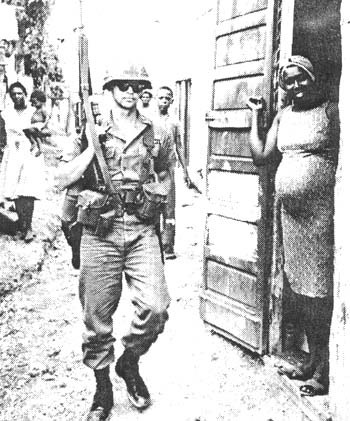Dominican Republic 1965

U.S. troops patrolling the streets of Santo Domingo
The Good Neighbor policy came to an official end in 1965, in the Dominican Republic . When, as discussed in chapter six of the book, the country's long-time dictator was assassinated with active U.S. support, he was eventually succeeded by a freely elected president, Juan Bosch. Seven months later, Bosch, seen by the military and segments of the U.S. mission as too much on the left, was overthrown, with the new junta soon being granted U.S. recognition. That regime, however, was no more stable, and on 24 April 1965, a revolt broke out in which junior officers, with considerable popular support from Bosch's followers, seized major parts of the capital, Santo Domingo . The U.S. reaction, from top to bottom, was negative. At the embassy, diplomats, CIA officers, and military attachés all worked to encourage rightist elements in the Dominican military to fight against the rebels rather than go along with them; in Washington, Johnson told the official he considered an expert, “We are going to have to really set up that government down there, run it and stabilize it some way or another. This Bosch is no good”; and the State Department, concerned with the “prevention of [a] possible Communist takeover,” suggested establishing a new military junta. This was pushing on an open door: on 28 April, the country team wrote that “issue here now is fight between Castro-type elements and those who oppose it.” Three hours later, the rightist forces asked for U.S. military intervention, a request agreed to by Johnson on the grounds that U.S. citizens were endangered (this was a gross exaggeration, to put it mildly). The country team, whose members had been bombarding Washington with “memos predicting doom if we did not send in the Marines,” then escalated further, pointing out that with the “situation deteriorating rapidly” and rightist officers “dejected and emotional ... weeping ... [and] in hysterical mood,” U.S. troops could take on a broader mission, namely, to “go beyond the mere protection of Americans” so as “to prevent another Cuba.” 1
Over the next two days, Johnson issued orders for more marines to land. The rightist forces were incapable of doing anything (“just sat on their bitty box over there and haven't done a darned thing”) and since the U.S. was “not willing to let this island go to Castro,” the U.S. would have to send troops. But although the leftist forces were momentarily on the offensive, they were not remotely “capable of imposing [their] will” outside of Santo Domingo , much less against U.S. forces; the Secretary of Defense estimated that “one to two divisions can clean up the island.” On 1 May, the general chosen to command U.S. forces received this order: “Your announced mission is to save US lives. Your unannounced mission is to prevent the Dominican Republic from going Communist. The President has stated that he will not allow another Cuba – you are to take all necessary measures to accomplish this mission. You will be given sufficient forces to do the job.” Eventually, some 23,000 troops would be deployed, taking up positions between the two sides, while covertly aiding the rightist forces. Negotiations ensued, with the U.S. making approaches to Bosch and his supporters, but, because of mistrust by both the leftists and Washington, these never quite succeeded. In the end, the U.S. forces gradually tightened the noose around the rebels, splitting them in half and compelling them to surrender most of their arms to a supposedly neutral government. The next year, the U.S. provided large-scale covert political support to help elect as president one of the late dictator's most trusted officials. 2
1) Draper (1965: 37-41); Johnson in conversation with Mann, 26 April 1965; State to Santo Domingo, 27 April 1965; Bennett to State, 28 April 1965; Bennett to Carter, 28 April 1965; Memorandum of Telephone Conversation, 28 April 1965; Mann in conversation with Johnson, 28 April 1965; Bennett to Carter, 28 April 1965; Bennett to Carter, 28 April 1965; all FRUS 1964-1968 , vol. 32: docs. 22, 24, 27, 29, 31, 38, 32, 36; Draper (1971); Lowenthal (1972: chs. 3-4). It should be noted that the FRUS volume on the Dominican crisis has only spotty coverage of a number of important episodes, particularly in the early days of the revolt; for a more rounded story, it is necessary to consult the now voluminous secondary literature based on interviews, congressional hearings, and, most recently, archival materials. This last set of holdings includes tape recordings of some 30 hours of telephone conversations between Johnson and his advisers on the subject of the Dominican Republic; it is estimated that Johnson met his advisers around 180 times about the crisis during its first nine days (McPherson 2003: 128n2, 129).
2) Raborn [CIA director] in conversation with Johnson, 29 April 1965; Johnson in White House meeting, 30 April 1965; “Situation and Outlook in the Dominican Republic,” OCI No. 1496/65, 2 May 1965; McNamara in White House meeting, 30 April 1965; Wheeler to Palmer, 1 May 1965; all FRUS 1964-1968 , vol. 32: docs. 39, 42, 50, 42, 43, and, on covert political support, docs. 150, 152, 155, 157.
